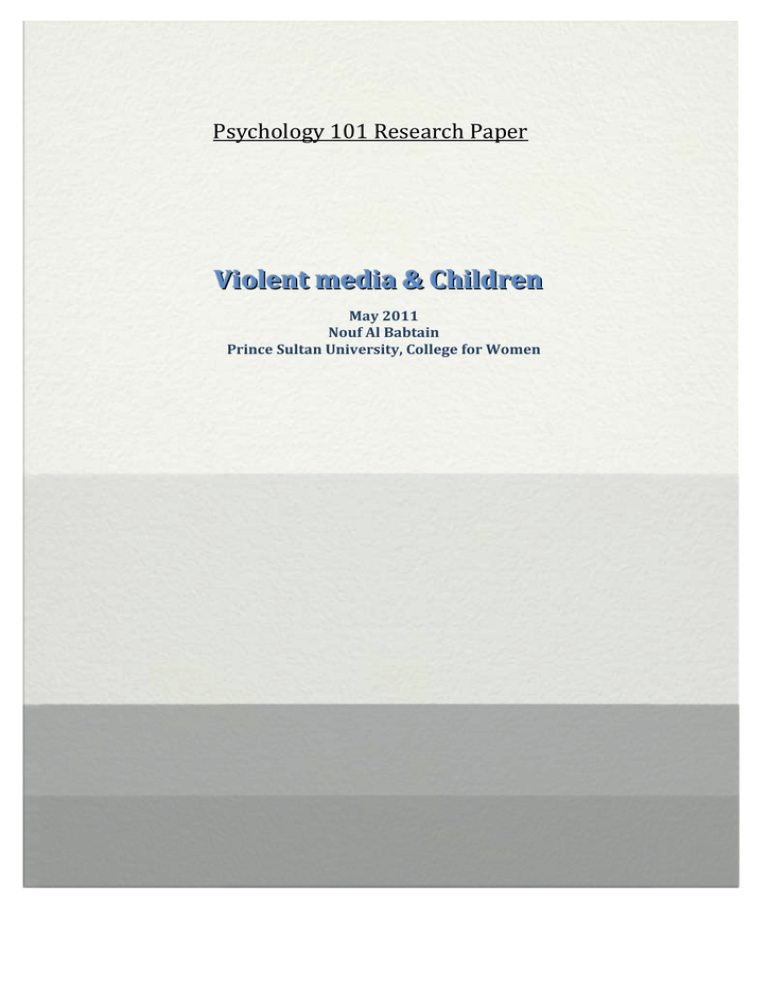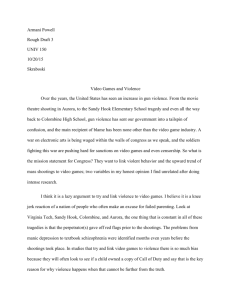Violent Media & Children
advertisement

Psychology 101 Research Paper Violent media & Children May 2011 Nouf Al Babtain Prince Sultan University, College for Women INTRODUCTION I believe television is going to be the test of the modern world, and that in this new opportunity to see beyond the range of our vision we shall discover either a new and unbearable disturbance of the general peace or a saving radiance in the sky. We shall stand or fall by television. —Author E. B. White. Television and other media represent one of the most important and under recognized influences on children and adolescents' health and behavior in the 1990s. Their impact should be eliciting serious concern, not just from parents and educators but from physicians, public health advocates, and politicians as well. Although objections to various programming and advertising practices can exist on common sense, philosophical, aesthetic, humanistic, or public health grounds without strict scientific data, to increasing numbers of studies document that a serious problem exists. Therefore, the big question is “What can I do to keep the media from being a bad influence on my child?” It's hard to understand the world of early adolescents without considering the huge impact on their lives of the mass media. It competes with families, friends, schools and communities in its ability to shape young teens' interests, attitudes and values. Literature Review We know from research such as that conducted by George Comstock and Erica Sherrar that seeing too much TV violence appears to increase aggressive behavior in children and that regular viewing of violence makes violence less shocking and more acceptable. U.S. Department of Education reported that the mass media infiltrate kids lives. Violent Media & Children Most young adolescents watch TV and movies, surf the Internet, exchange emails, listen to CDs and to radio stations that target them with music and commercials and read articles and ads in teen magazines. First, look on the bright side. The new media technologies can be fun and exciting. Used wisely, they can also educate. Good TV programs can inform, good music can comfort and good movies can expand interests and unlock mysteries. Additionally, many forms of media are being used in classrooms today-computers, cable-equipped TVs and VCRs are all part of the landscape. Indeed, recent years have seen a commitment to connecting every classroom to the Internet and providing a reasonable number of computers to each classroom for student use. As a result, children need to be exposed to media, if only to learn how to use it. The problem is that young adolescents often don't--or can't-distinguish between what's good in the media and what's bad. Some spend hours in front of the TV or plugged into earphones, passively taking in what they see and hear--violence, sex, profanities, stereotyping and story lines and characters that are unrealistic. Moreover, students who report watching the most TV have lower grades and lower test scores than do those who watch less TV. "In any classroom discussion I have, it is very apparent whose watching [a lot of] television and who's not," explains teacher Sherry Tipps. "For the kids who are not motivated in the classroom, mention TV and suddenly they perk up." As young teens mature, high levels of TV-viewing, video game playing and computer use take their toll. On average, American children spend far more time with the media than they do completing work for school. Seventh graders, for example, spend an average of 135 minutes each day watching TV and 57 minutes VIOLENT MEDIA & CHILDREN 3 doing schoolwork. Moreover, add to these negative psychological and academic effects, negative physical effects. Recent reports by the U.S. Surgeon General show that the number of overweight teens in American has increased greatly over the past two decades. Being overweight, in turn, can contribute to serious health problems, such as diabetes. Negative influences also come from other media. For example, a growing number of ads in magazines, including some for harmful products such as alcohol and tobacco, are targeted at young adolescents. Participants I have distributed a survey on 25 students at Prince Sultan University, all females, their age group is between (18-25). Instruments I used Microsoft Word to write the research paper, Microsoft Excel for the graphs and charts, and Kwiksurvey. to make a survey and get the results. Method The method that I’m using in this research is the correlational method. I have distributed a survey among Prince Sultan University students, and I used books and the web to support my research, Results By conducting how many people thinks that media has a bad influence on children, the result was a very large number of 79% who have said yes. And also big number has agreed that media promotes violence to children. Which has inspired me and motivated me to choose this subject as my topic. The survey questions and the results will be attached with the research papers. Matthew A. Lapierre, M.A., and colleagues at the University of Pennsylvania, Philadelphia, evaluated 80 children between the ages of 4 and 6 years (average Violent Media & Children age 5.6 years), to determine if using a licensed spokescharacter on food packaging affects the child choice. Children were shown boxes of cereal labeled Healthy Bits, some boxes featuring media characters. Participants were asked to rate the taste of the cereal on a scale of one to five. So those who saw a popular media character on the box reported liking the cereal more than those who viewed a box without a character on it. "The results of this experiment provide evidence that the use of popular characters on food products affects children's assessment of taste, which is a good way of using media to stimulate them to eat. So we should focus on this kind of media other than focusing on violence. Discussion As you can see the media has a great way to teach our children things they need to know in life, and help us to make the kids desire healthy food and life style . Moreover, The bad media has affected the children and they started to act violent according to what they see and sometimes they become out of control as they imitate their favorite character in a violent movie. To avoid all of the bad behavior media has influenced on the children, they will benefit from our guidance in helping them to balance media-related activities with other activities such as reading, talking with family and spending time with friends. Here are some ways that I found on a report for the U.S Department of Education, which can help the children to make good media choices: * Limit the amount of time children spend viewing TV. It's impossible to protect the child entirely from the media. Let them watch only special programs that are agreed upon. * Monitor what children watch and listen to. Former principal Carole Kennedy VIOLENT MEDIA & CHILDREN 5 advises, "Don't just listen to how loud the music is, but to what the words are. *the parents can also watch or listen with their child. This allows them to spend time with him and to learn more about the programs. * Suggest TV programs that you want your child to watch. Encourage children to watch TV programs about a variety of beneficial subjects. * Talk with children about the difference between facts and points of view. Young teens need to learn that not everything they hear or see is true. Conclusion In conclusion, the media can be highly beneficial and a perfect source of getting information and knowledge if it was used in a good way. Otherwise, it will harm and affect the way the children think and act according to what the media is offering to them if it was used in a bad way. So we should avoid the bad and violent media our children watch as much as possible to prevent accidents and violent behaviors. Violent Media & Children References Mediated: How the Media Shapes Our World and the Way We Live in It by Thomas De Zengotita (Feb 21, 2006). The Problem of the Media: U.S. Communication Politics in the Twenty-First Century by Robert Waterman McChesney (Mar 1, 2004). Media/Society: Industries, Images, and Audiences by Dr. David R. Croteau, William Hoynes and Dr. Stefania Milan (May 17, 2011). Media, Crime, and Criminal Justice by Ray Surette (Aug 3, 2010). Gentile, D A, Mathieson, L C, & Crick, N R (May 2011). Media Violence Associations with the Form and Function of Aggression among Elementary School Children. Social Development, 20, 2. p.213(20). Retrieved May 30, 2011, from Academic OneFile via Gale: http://find.galegroup.com/gtx/start.do?prodId=AONE&userGroupName=cwpsu. Timmer, J. (Spring 2011). Restricting portrayals of film violence to reduce the likelihood of negative effects in viewers: did the framers of the Motion Picture Production Code get it right?. Journal of Popular Film and Television, 39, 1. p.2936. Retrieved May 30, 2011, from Academic OneFile via Gale: http://find.galegroup.com/gtx/start.do?prodId=AONE&userGroupName=cwpsu. -Cartoon characters beat health claims. Jan-Feb 2011 v27 i1-2 p24(1)Pediatrics for Parents, 27, 1-2. p.24(1). Retrieved May 30, 2011, from Academic OneFile via Gale: http://find.galegroup.com/gtx/start.do?prodId=AONE&userGroupName=cwpsu. VIOLENT MEDIA & CHILDREN 7 Survey (Questions & Results) 1. Do you think TV effects how violent children behave? 20% Yes No 80% 2. How often do children in your home sit beside TV? 24% 8% 68% Always Most of the time Sometimes Violent Media & Children 3. After watching a violent TV show, have you ever noticed any change in the behavior of children in your home? 8% 32% Always Sometimes Never 60% 4. Do you think decreasing the amount of violent media children watch will decrease their bad behavior? 12% Yes 16% No 72% I don’t know 5. Do you think media has a bad influence on people? 8% 13% Yes 79% No I don’t know VIOLENT MEDIA & CHILDREN 9 6- Please explain your answers for 5 below. - There is an immediate effect on the behavior of people across ages. - Hate and racism. - Because it may change their way of thinking and they might behave badly - People talk or believe the things in the media and consider it a fact. It affects the way they react and copy their trends and attitudes. - Because media sometimes talk about something that isn’t true and that will lead to a huge impact on children’s belief. - Because people are highly effected by media. So when something bad kicks in, they will absolutely respond to it. - It shows the children a bad behavior and actually teaches them how to do it. Its extremely dangerous. - 1-it sets stereotypes (e.g. blondes are stupid) 2- promotes violence and bullying and anorexia.




